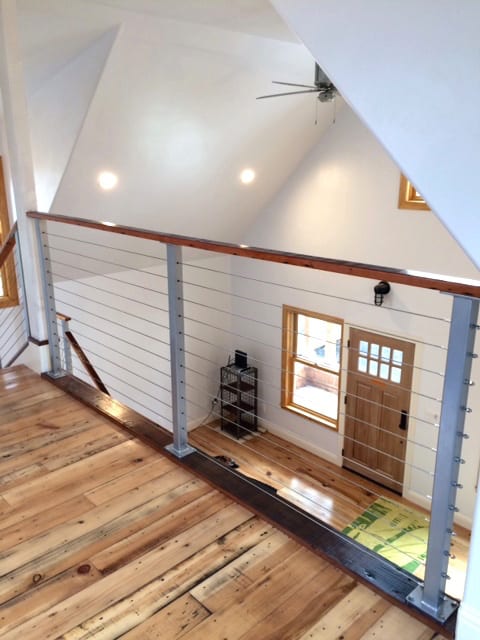




Residential railing projects will often involve wall mounted applications both inside and outside the home. Pony walls, retaining walls, parapet walls, and interior partition walls are often used as mounting points for railing frames. A modern railing system can be a sturdy and attractive way to dress up an existing wall. Cutting down or lowering the height of an existing wall while adding railings is also a very popular remodeling choice. Here are some of our favorite wall mounted railing applications for commercial and residential railing projects: Wall Mounted Stair Railings A large percentage of interior and exterior stairways include short pony walls that require railings and/or handrails. Older track homes will often feature walls like this as the sole means of a fall barrier. While a wall is an effective fall barrier, it might not be the most attractive option. Many of our customers choose to cut down or completely remove these walls in order to open up and modernize their homes. Wall top railings are easy to install with pre-made surface mounted railing posts and DIY cable hardware. Custom glass panels, vertical cable, and horizontal rods are also popular choices for modern stair railings. Parapet Wall Railing Installations Rooftop decks and balconies often utilize parapet walls for structural and drainage reasons. Frameless glass “boot” systems or “base shoe” glass railings are a popular choice for these applications. Waterproofing and protecting perforations is a must when performing parapet wall railing installations. Additionally, we recommend the use of T316 marine grade stainless steel on all coastal applications. San Diego Cable Railings offers a full line of stainless steel glass railing posts, clips and hardware. Ultra transparent tempered glass panels and high quality hardware make these an extremely safe railing choice for parapet wall mounted railings. Best Railings for Retaining Walls Retaining walls and masonry fencing are commonly used for residential barriers on the exterior of the home. They can also be used to retain dirt and support patio slabs when a raised concrete or tile patio is desired (photo above). Mounting a railing system to a retaining wall is possibly the sturdiest way to make a railing connection. Properly designed wall mounted railings basically feel like a block wall. Steel posts with welded base plates are a great option for mounting to a retaining wall railing or fence. Epoxied rods or masonry wedge anchors are used to secure the posts to the wall. Stainless steel cable or glass panels can be utilized for infill as a safe and attractive option for retaining walls. Mounting a Handrail to a Wall Commercial and residential stairways often require grab rails or “graspable railings” in order to meet code requirements. In many of these situations there is a wall on both sides of the stairs (photo above). The solid wall is used to mount the grab rail with mounting brackets and the opposing wall is used to mount the barrier railings with infill. The photo above illustrates a beautiful stainless railing system installed in an industrial complex in San Diego, CA.